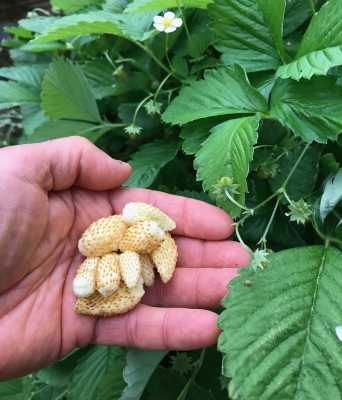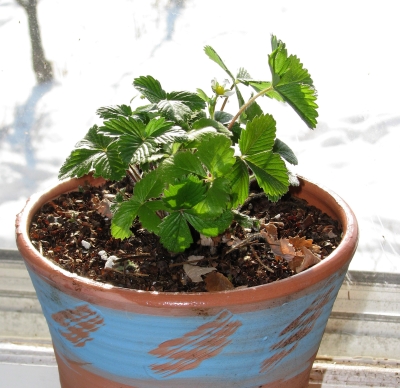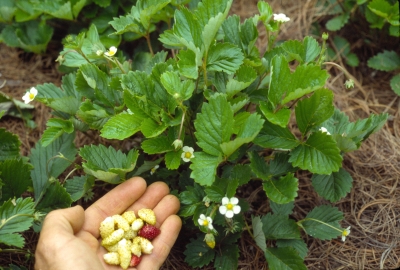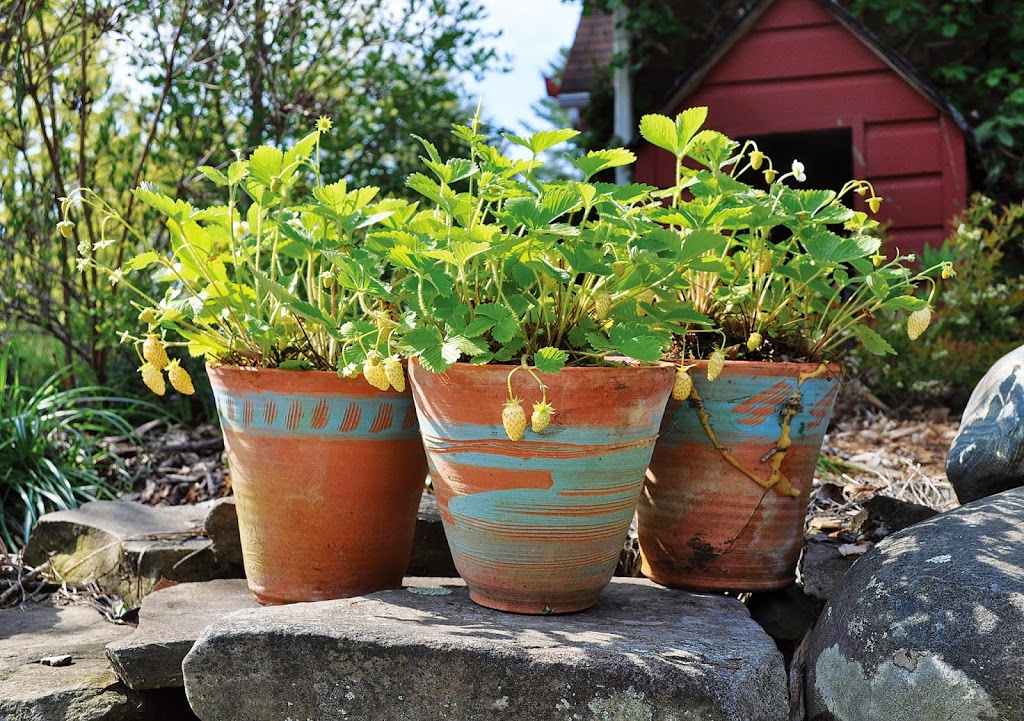A New, Old Twist on Strawberries
Strawberries White and Early
Awhile ago I plucked some ripe strawberries and handed them to Rachel for a taste. Her ho-hum reaction told me that I hadn’t picked carefully enough. Yes, the berries were white, but that’s their color when ripe — and also when not ripe. You should be scratching your head by now. Strawberries that are white when ripe? Strawberries perhaps ready for harvest in early May here in the Hudson Valley?
You should be scratching your head by now. Strawberries that are white when ripe? Strawberries perhaps ready for harvest in early May here in the Hudson Valley?
The berries I handed Rachel were alpine strawberries (Fragaria vesca), a different species from our usual garden strawberries (F. X ananassa). They are a kind of “wood strawberry” (often going under their more upscale-sounding French moniker fraises de bois) first encountered about 300 years ago near Grenoble, France. These strawberries are different from garden strawberries in many ways.
For one thing, alpine strawberries are everbearing. They’ll pump out fresh berries as long as given sufficient warmth, water, and nutrients. Mine are bearing now because they’re planted in the ground in my greenhouse. In my pre-greenhouse life they fruited for me in early spring in 3” diameter pots in a sunny window. And no, the plants hadn’t resided in my home and aren’t now in my greenhouse to protect them from winter cold. I wanted an earlier crop. I also grow them outdoors.
And no, the plants hadn’t resided in my home and aren’t now in my greenhouse to protect them from winter cold. I wanted an earlier crop. I also grow them outdoors.

‘Pineapple Crush’ strawberries
Alpine strawberry plants are adapted from where winter temperatures plummet below minus 30°F. to regions that hardly experience winter.
These strawberries also part ways with garden strawberries in not producing any runners. I consider this a plus because the worst weeds in a garden strawberry bed are often the plants themselves. As runners strew about and take root, they crowd each other out. The resulting shade and higher humidity make for lower yields and plants more prone to disease.
About 40 years ago, alpine strawberries were hybridized with garden strawberries, with the resulting plants showing typical hybrid vigor with larger fruits and more robust growth. The variety Florika was one of those hybrids, billed as having very good flavor and sufficient vigor and disease resistance so that it can be planted to create a fruiting meadow. Sara and Rebecka are two other hybrids. (Unfortunately, all are red-fruited.)
I’ve never grown any of these hybrids, but will — very soon. Stay tuned.
Small, But Very Easy to Grow
Alpine strawberries are not the strawberries to grow to fill your freezer for winter. Unless you have a lot of patience, that is, because the berries are small, typically about the size of a dime. (The hybrids bear larger fruits, measuring over an inch long.)
You also will rarely, if ever, find the ripe fruits for sale. If they are truly ripe, they are very, very soft, and very, very perishable. The only way to truly experience these berries them is to grow them yourself (easy) and then harvest them dead ripe (pretty easy).
The plants thrive in moderately rich, well-drained soil in full sun or partial shade. In pots, any basic potting mixture will suffice.  A planting can be started from plants or seeds, the latter started just as are tomatoes. Plants grown from seeds planted in spring will begin bearing their first season.
A planting can be started from plants or seeds, the latter started just as are tomatoes. Plants grown from seeds planted in spring will begin bearing their first season.
New plants can also be made by dividing old plants, cutting the crown into pieces along with their attached roots. As with many herbaceous perennials, division or starting new plants is a necessity as plants age and their centers become woody and decrepit.
As far as timely harvest, one way is to follow your nose; the berries are extremely fragrant when ripe. Look at the berries: Ripe ones turn from white to creamy yellow, and their seeds darken to brown. Just the gentlest coaxing removes a ripe fruit from its stem.
Scrumptious!!
A number of gardeners grow alpine strawberries, the red-fruited kinds, which come in a number of varieties. There are, likewise, many varieties of white-fruited alpine strawberries. One year I decided to see just how different these varieties are from one another. It turned out that all the red-fruited ones were similar, as were the white-fruited ones. For me, the white ones definitely had better flavor. And the flavor could be enjoyed. Why? Because until they are dead ripe, alpine strawberries have taste somewhat akin to cotton soaked in lemon juice. Problem is that birds are very attracted to, and eat, the red fruits no care as to whether or not the berries are dead ripe.
It turned out that all the red-fruited ones were similar, as were the white-fruited ones. For me, the white ones definitely had better flavor. And the flavor could be enjoyed. Why? Because until they are dead ripe, alpine strawberries have taste somewhat akin to cotton soaked in lemon juice. Problem is that birds are very attracted to, and eat, the red fruits no care as to whether or not the berries are dead ripe.
Birds don’t notice the white fruits when they are ripe so leave them alone for our enjoyment.
A few days ago, when I again saw Rachel, I offered her some more carefully picked fruit. She put them in her mouth, blinked and then open her eyes wide, and exclaimed, “Wow!” That’s the usual reaction to the fruit. Ripe, the white fruits are sweet and richly aromatic with a commingling of scrumptious flavors of strawberry and pineapple.
———————————————
Any gardening questions? Email them to me at garden@leereich.com and I’ll try answering them directly or in this column. Come visit my garden at www.leereich.com/blog.



I tried making jam out of them one time, they turn to brown mush. Not a good idea. Not sure what happened to them in my garden but they didn’t survive long here in zone 8b.
Wow, I have wanted to try these for awhile. I wish I could have success growing these from seed! I have tried the past two years and have gotten good germination, but the little seedlings all shrivel and die soon after the first true leaves appear. The tiny leaves looked scorched and I thought they were getting too much sun in our greenhouse, so tried putting them under the table in some shade this year but the some thing is happening…. anyone have some tips to get them to grow to a full size plant?
I don’t think it’s too much light. I grow my seedlings in full sunlight. Perhaps something in the potting mix or too much or too little water. The plans self seed freely so you could, once you get plants, just transplant seedlings.
Strawberry seeds?
Wonder how one collects seeds. Can one collect seeds from red strawberries too?
Just mush the berries up with a fork in water (or, gently, with a blender). Let them sit in the water for a couple days, stirring and changing the water occasionally. Each time, pour off the old water along with any floating flesh and seeds. Eventually, collect the small seeds that sink in the water in a fine sieve or with filter paper, and let them dry out. This works for all strawberries.
I was wondering if you have any guidance on the newer “bush cherries”, Romeo and Juliet. Apparently Juliet is more of a small tree?
I tried both Romeo and Juliet, and both seemed too susceptible to pests to continue growing.
Lee, Would you see any issues with covering the plants with bug cloth to protect them from birds and bugs? Is there an acceptable timing that would work, like after the berries are set, but not ripe?
I’ve never had enough bug problems with my strawberries to warrant covering them to keep them out. For the birds, I cover the plantsjust as the very first berries start to turn red.